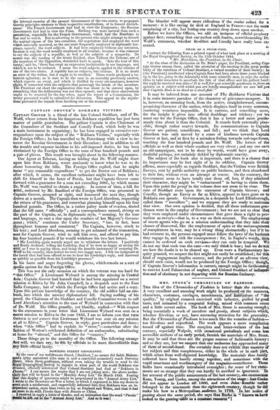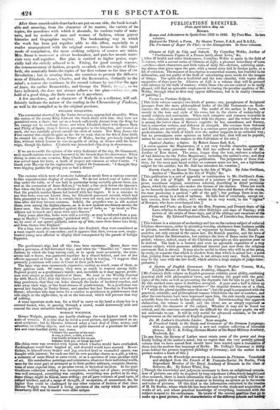MRS. STONE'S CHRONICLES OF FASHION.
THE idea of the Chronicles of Faddist is better than the execution. A very excellent and amusing work might be prodeced on the manners, characters, costumes, carriages, amusements, 'and' bithitations of "the quality," by original research exercised with industry, guided by good taste, and animated by a congenial feeling, mixed with common sense and a little covert satire. The book of Mrs. Stone is amusing enough ; being essentially a work of anecdote and gossip, about subjects which, whether frivolous or not, have unceasing attraction for the generality. But the Chronicles of Fashion is too much Me the votaries of fashion— too frivolous and superficial. The work appears a mere compilation tossed off against time. The essayists and letter-writers of the last century, especially Walpole, with occasional periodicals and some lea accessible authors of an early period, furnish the materials of Mrs. Stone. It may be said that these are the proper sources of fashionable history: and so they my, but.we suspect that our authoress has approached many of them at 'second-hand. She certainly does not exhibit that mastery of her subject and that completeness, either in the whole or in each part, which arises from well-digested knowledge. The materials thus hastily collected have been hastily strung together, and sometimes with the vapid smartness and wordmongery of the magazine-contributor. These faults have occasionally introduced oversights ; for some of her etate- ments are so strange that they can hardly be ascribed to ignorance. lit her account of the public amusements of the last century, she enumerates Kean, Young, and Cooke, among the attractions of the stage : but Cooke did not appear in London till 1800, and even John Kemble rather belonged to the nineteenth than the eighteenth century, though he did make his bow to a Metropolitan audience in 1793. In her notice of gaming about the same period, she says that Burke is " known to have looked to the gaming-table as a constant resource " !
After these considerable drawbacks are put on one side, the book is read- able and amusing, from the character of its matter, the variety of its .
topics, the anecdotes with which it abounds, its curious traits of man- 'ners, and its notices of men and women of fashion, whom graver -histories and biographies neglect. The bookmaking way in which the work has been put together adds to this effect, especially to a reader unacquainted with the original sources ; because in this rapid mode of compilation, the more striking subjects of course are taken. Mrs. Stone is moreover a clever bookmaker, and puts her mosaic mate- rials very well together. Her plan is entitled to higher praise, espe- .eially had she strictly adhered to it. Fixing, for good enough reasons, the commencement of fashion, properly so called, with the reign of Eliza- beth, she nominally limits the topics of her first volume to the time of the -Revolution ; but in treating them, she contrives to present the different 'eras of Elizabeth, James, Charles, and the Restoration, distinctly to the mind; a course she continues in the second volume by marking the ages of Anne, the earlier Brunswieks, and George the Third ; thongh, as we have indicated, she does not always adhere to her plan —when she gets bold of a good thing, she finds room fin. it anywhere. A few anecdotes, and a character of Walpole as a collector, will suf- ficiently indicate the nature of the reading in the Chronicles of Fashion, as well in the compiled as in the original portions.
ENGLISH ETIQUETTE.
- The ceremonial observed by the Tudor Sovereigns approached absurdity. When the sisters of the young King Edward the Sixth dined with him, they were not permitted even a chair; but sat on a bench sufficiently distant from the King for his canopy not to overhang them; and when Elizabeth dined with Queen Mary and Philip of Spain, though heiress presumptive to the kingdom, and treated as =eh, she was carefully placed outside the cloth of estate. But King James the rust carried this etiquette quite as far: for we read, that on the 4th of June 1610, lie created his son Prince Henry Prince of Wales, having previously knighted him, without which honour Le was incapable of sitting at dinner with his Sove- reign, though his father. Elizabeth was intrenched chin-deep in observances.
• • • • ..If we are to credit the opinion of the witty fashionist of the day, De Grammont, mulch manifestations were more honoured in the breach than the observance. When dining in state on one occasion, King Charles made his favourite remark that be vas served upon the knee, a mark of respect not common at other Courts.' " I think ydur Majesty for the explanation," replied De Grammont; "1 thought they were begging pardon for giving you so bad a dinner." '
FORKS. •
The customs which were of necessity habitual at meals form a curious contrast to this superabundant display of etiquette. We do not indeed read of ladies sit- ting under the table, or of one lady in particular being enviably placed there, (as east at the coronation of Anne Boleyn,) "to hold a fine cloth before the Queen's face when she list to spit, or do otherwise at her pleastire." But most certain it is that the prudish maiden Queen fed herself.with her fingers. It is a mistake to say that forks were not known then, for Elizabeth messed several, which had been presented to her; but it is certain they were not used, nor for a considerable time after did they become common. Indeed, the prejudice was as rife against them, even among the higher,slasses,as it is now againstmaehinery among the lower ones. - One divine 'preached against the use of forks, as •" an insult on Pro- yidence not to touch one ea
meat with one's fingers." • • •
Forty years after this, forks were still a novelty; as may be inferred from a pas- sage in Heylin's " Cosmography," published 1652. " The use of silver forks with us, by some of our spruce gallants, taken up of late, came from hence into Italy, and from thence into England.". For a long time after their introduction into England, they were considered as a most superb mark of coxcombry; and it appears that then, even as now, empty- leaded young men affected to display their consequence by the parade of foreign fopperies WIGS-
The gentlemen's wigs had all this time been enormous. Queen Anne was
:quite a patroness of full-bottomed wigs; and when the "Ramifies tie" came into fashion, by which the long waving curl, or to speak more accurately, the mon- strous tail or fleece, was gathered together by a riband behind, and one of her officers appeared at Court in it, she said to a lady in waiting, "1 suppose that presently gentlemen will come to Court in their jack-boots." The large wigs were enormously expensive; costing as much, some of them, as forty guineas each. Of coarse, they were as much in request among light- fingered gentry as a gentleman's watch; and, incredible as it may appear, gentle- men were almost as easily deprived of them. We read hi the Weekly Journal for 30th March 1717, that the thieves have got such a villanous way DOW of rob- bing gentleinen, that they cut holes through the backs of hackney-coaches, and take away their wigs, or fine head-dresses of gentlewomen. So a gentleman was served last Sunday In Tooley Street, and another but last Tuesday in Fenchurch Street; wherefore this may serve for a caution to gentlemen or gentlewomen that ride single in the night-time, to sit on the fore-seat, which will prevent that way of robbing. i A most ingenious mode was, for a thief to carry on his bead a sharp boy in a -covered basket, who, in passing through a crowd, would dexterously seize and conceal the most attractive-looking periwig.
HORACE WALPOLE.
Horace Walpole, perhaps, can hardly challenge the very highest rank in the scale of virtuosi. It is true that he loved a good picture, and appreciated an un- *lent sculpture; but he likewise frittered away a vast deal of time, money, and vacation, on trifling objects, and was not quite innocent of a penchant for snuff- .110i and cane-handled Mills; nay, worse,
"China's the passion of his soul : A cup, a plate, a dish, a bowl, Can kindle wishes in his breast, Inflame with joy, or break Ms rest."
Mt china-room was crowded with bijoux which Charles would have overlooked, Buckingham would have laughed at, and Arundel would have scorned. Never- theless, to himself every beaker and jug, cracked bowl or enamelled saucer, was fraught with interest; for each one had its own peculiar charm as a gift, a token, a. memento of some friend or some event, or as a specimen of some peculiar style of art. His numberless paintings and miniatures, whatever their individual worth, were for the most part so arranged as to form perfect tableaux, complete illustra- tions of some especial time, or peculiar event, or historical incident. In his mul- titudinous collection nothing was incongruous, nothing out of place; everything was well arranged, everything was complete, everything was perfect in its way. Some things might be finical, some trifling; yet all gave evidence of good taste, of -refined intellect, and of a range of thought, of occupation, of amusement, far, far higher than could be challenged by any other votarist of fashion of that time. Horace Walpole was himself a living specimen of the rarity which he prized:
Strawberry-Hill and its master were alike unique. .



























 Previous page
Previous page